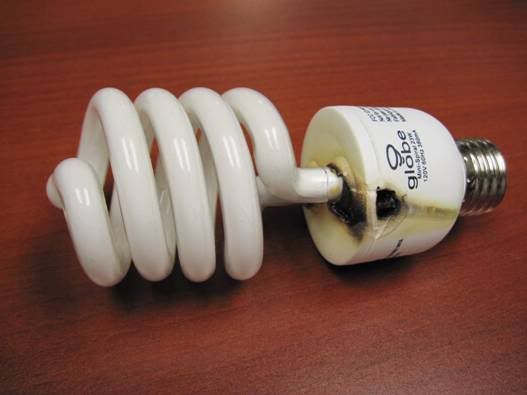
Posted on 11/19/2013 7:04:01 PM PST by Rabin
A PNNL staff member removed a burned-out compact piggy tail light bulb in his home and replaced it with a new one. When he turned on the switch, only a portion of the new bulb lit up. Assuming it was defective, he turned off the switch to remove it. Grasping the bulb, he felt a pain as if he had been cut by glass, and found a small, burn. Removing the bulb, he noticed the plastic base (see pix) was blackened at the point where it connected to the mercury tube.
(Excerpt) Read more at msa.hanford.gov ...
Get LED bulbs. They DO last, and they use even less energy than CFL.
You have to use them right, I only use them places where the lights will not be turned on and off relatively quickly (bathrooms), especially hard to reach places. My bulbs consistently last a few years each.
They have finally gotten down to the price point where I am considering them.. Sadly, they aren't THAT much more efficient than CFL's. I was hoping for a reduction on the level between incandescent and CFL (Factor of 4 or so).
Build quality does vary.
Teardown of a couple of cheapo Chinese LED lamps: www.youtube.com/watch?v=BKUEgnLpeQo
I buy Cree lamps, made in North Carolina.
Sure wish they’d hire me...
My best flashlight is a 12 LED bulb type and it is bright and has lasted about 10 or 11 years. It is my go to light when all the others are dim and/or burnout. It always works. And always has a very bright beam. Guess I was lucky.
But the commute's a killer...
I’ve had two fires caused by CFLs. They are very dangerous.
The A19 is 7W. The 100W CFL equivalent is 26W; that's pretty close to a factor of 4. Add to that the fact that the LED bulb will actually outlast its warranty (in 5 years I have never replaced one) and the CFL bulb will be lucky to get to 25% of its imaginary lifetime and it's a no-brainer.
It's especially pronounced in vanity lighting. We went from 3 x 45W teardrop bulbs to 3 x 2W LED's in the bathroom fixture, and now have more light, and more natural light. Many LED's can also be adjusted with a rheostat, a feature you will not find in CFL at any price.
It's interesting that they offer both a 9.5w dimmable bulb putting out 800 lumens of 2700K light and a 13.5w dimmable bulb also putting out 800 lumens of 2700K light. Same lifetime and warranty.
But why would you ever buy the 13.5w model? 84 lumens per watt vs 59, but otherwise the same!
Comparison by Home Depot.
Hmm. Looking at the full descriptions, I see the 13.5w model claims "Neodymium glass augments LED light quality through spectral notching". Maybe that's it. The filtered light is easier on the eyes, but the lamp has to be stronger to overcome the envelope losses to still put out 800 lumens?
bttt

Yes, I was able to find a data sheet that shows it takes a big bite out of the yellow, which is near the peak sensitivity of the human eye. That increases the relative amount of red perceived, giving a warmer light. I’d guess it gives a better red-green color differentiation s well.
www.cree.com/~/media/Files/Cree/Lighting/Lamps/Bulb/TWseriesFAQ.pdf
The 42% higher energy consumption must be due to the Neodymium. I guess I'll have to try out one of each to see if the improved CRI makes a worthwhile difference.
Although I am sure that some effort will be given on this matter (hence the article). Back during the war when Hanford was creating the material for the first atomic bombs, all of the housing was governmental, and maintenance guys did all of this sort of work - changing light bulbs, plumbing, cleaning, etc. Mainly to snoop on the workers to make sure they didn't bring anything home from work (files, papers, etc.).
Perhaps the LEDs. But the electronics behind the LEDs still often have cheap Chinese capacitors, so they don’t last anything like that long.
When I was a kid, we used to play with mercury. It’s an interesting liquid.
Disclaimer: Opinions posted on Free Republic are those of the individual posters and do not necessarily represent the opinion of Free Republic or its management. All materials posted herein are protected by copyright law and the exemption for fair use of copyrighted works.